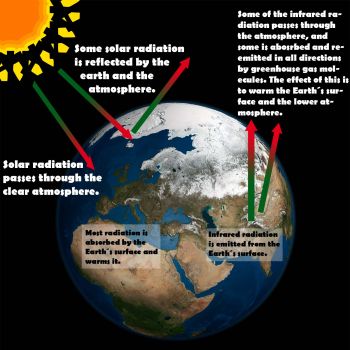Contributing to Climate Change
 Click to enlargeMost of the observed temperature increase since the 1940-50's were caused by increasing concentration of greenhouse gases. They are gases in an atmosphere that absorb and emit radiation within the thermal infrared range.
Click to enlargeMost of the observed temperature increase since the 1940-50's were caused by increasing concentration of greenhouse gases. They are gases in an atmosphere that absorb and emit radiation within the thermal infrared range.
Greenhouse gases closely correlate human activity such as fossil fuel burning and deforestation. This process is the fundamental cause of the greenhouse effect.
Greenhouse gasses are in the correct amount are quite necesseray and natural and without them it has been estimated that the earth surface temperature would be on average 33 degrees colder.
The main greenhouse gases in the earth atmosphere are in accordance to their abundance:
- - water vapor
- - carbon dioxide
- - atmospheric methane
- - nitrous oxide
- - ozone
- - chlorofluorocarbons
From the beginning of the Industrial revolution the release of carbon dioxide or Co2 has increased dramatically. Most of the observed temperature increase since the middle of the 20th century was caused by increasing concentrations of greenhouse gases, which results from human activities.
Global dimming, a result of increasing concentrations of atmospheric aerosols that block sunlight from reaching the surface, has partially countered the effects of greenhouse gas induced warming.
Climate model projections summarized in the latest IPCC report indicate that the global surface temperature is likely to rise a further 1.1 to 6.4 °C (2.0 to 11.5 °F) during the 21st century. The uncertainty in this estimate arises from the use of models with differing sensitivity to greenhouse gas concentrations and the use of differing estimates of future greenhouse gas emissions.
An increase in global temperature will cause sea levels to rise and will change the amount and pattern of precipitation, probably including expansion of subtropical deserts.
Warming is expected to be strongest in the Arctic and would be associated with continuing retreat of glaciers, permafrost and sea ice.
Other likely effects include changes in the frequency and intensity of extreme weather events, species extinction, and changes in agricultural yields.
Warming and related changes will vary from region to region around the globe, though the nature of these regional variations is uncertain.
The scientific consensus is that anthropologic global warming is occurring. Nevertheless, political and public debate continues. The Kyoto Protocol is aimed at stabilizing greenhouse gas concentration to prevent a "dangerous anthropogenic interference". As of November 2009, 187 states have signed and ratified the protocol.
Sources: IPCC








